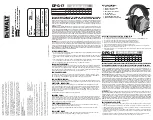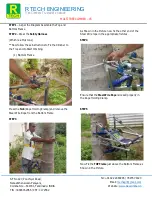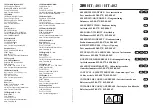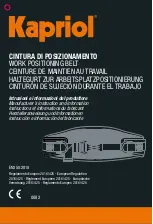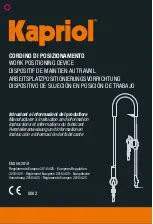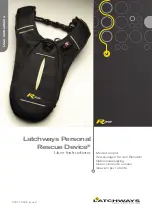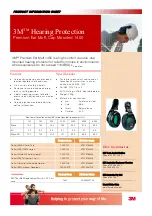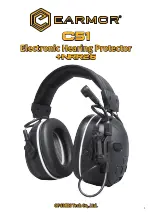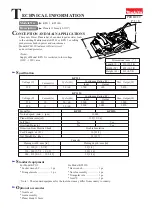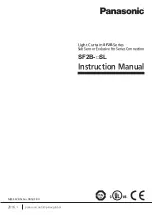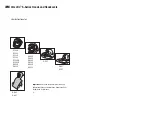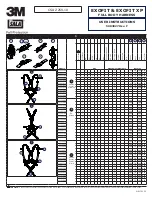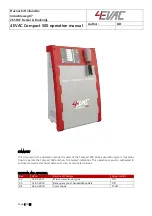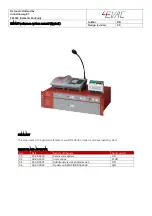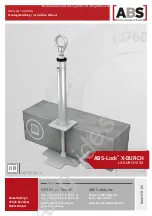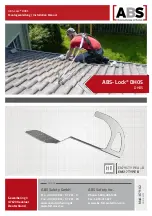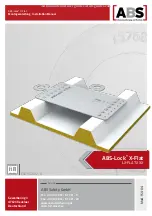
DPG17
USER MANUAL
CHARGING THE HEADSET:
To comply with regulatory guidelines, your hearing protector has been shipped to you with only a partial charge
on its integrated lithium ion battery pack. To charge the hearing protector, insert the supplied micro-USB con-
nector cable into the micro-USB jack located on the bottom of the right cup of the hearing protector. Connect the
other end of the cable to a suitable USB power source such as a computer or third party certified AC to USB wall
adapter. After charging is finished, the circut will stop charging automatically.
POWER AND VOLUME:
Press and hold power button for 3 seconds to power ON/OFF headset. Voice Assist will announce “Power
ON” or “Power OFF.” Voice assist will also provide a battery status update – “Battery High,” “Battery Medi-
um,” “Battery Low,” or “Battery Empty.” Adjust the volume using your connected device.
FITTING INSTRUCTIONS:
1. For best results, it is important that the ear muff is fitted and worn properly. Maximum attenuation will only
be achieved if the HPD is properly fitted.
2. Before ear muff is fitted to head, grasp ear cup with one hand, and headband with the other. Slide the ear
cup gently away from the headband. The wire headband frame will extend from the guide arms about one
inch.
3. Place ear muff on head, and gently collapse the headband frame into the guide arms until the headband
rests on top of the wearer’s head and the ear cups completely cover the wearer’s ears.
4. The ear cup with the power control should be worn on over the wearer’s right ear.
LOW BATTERY WARNING:
Hearing protector will also provide a “Battery Low” warning every 20 minutes when battery voltage is low. An
additional “Battery Empty” warning will occur as hearing protector powers down. Recharge the unit at this time.
BLUETOOTH
®
CONNECTION:
Once powered on, in quick succession, double press the ON/OFF button on the hearing protector’s right
cup to enter pairing mode. If you hear four chimes instead, try double pressing the ON/OFF button again in
quicker succession. Make sure your Bluetooth® enabled device is scanning/searching for devices. Check
your device to make sure it has discovered “D
E
WALT DPG17” Select “D
E
WALT DPG17” to connect to the
hearing protector. Once connected successfully, you will then hear “Bluetooth Connected” and the LED on
the right cup will turn blue.
Your Bluetooth® audio volume will be controlled by your device.
INCOMING CALLS:
In Bluetooth® Mode, incoming phone calls will cause the music to be muted and you will hear your phone’s
ringtone until the call has ended. To answer an incoming call, press the function button on the hearing pro-
tector once. To disconnect from a call, press the button once more. After disconnecting from the call you will
hear “Call Terminated.”To reject a call and return to Bluetooth® audio, press and hold the function button.
After rejecting a call you will hear “Call Terminated.”
FORWARD/BACK OR PAUSE*
Press the DOWN-seek button to play previous music again, press UP-seek button to play next music. To
pause, press the function button on the hearing protector once.
*Some devices may not be compatible with this feature and will have to be operated using their native
controls.
AUDIO INPUT MODE
Connect the device using a compatible 3.5mm stereo audio cable. Turn the hearing protector on. Use the
native controls on the device to control input volume, pause/play and select tracks.
ATTENUATION DATA
NRR 25
Frequency (Hz)
125
250
500
1000
2000
3150
4000
6300
8000
Mean Attenuation (dB)
18.6
22.9
31.8
35.4
33.2
39.7
42.3
36.7
37.1
Standard Deviation (dB)
2.1
1.8
3.3
3.1
2.0
4.1
3.4
5.9
4.8
Tested according to ANSI S3.19-1974 Standard
THE PROTECTION AFFORDED BY THIS HEARING PROTECTION WILL BE SEVERELY
IMPAIRED IF THE FOLLOWING WARNINGS & INSTRUCTIONS ARE NOT ADHERED TO.
Improper fit of this device will reduce its effectiveness in attenuating noise. Consult the enclosed instructions for proper
fit. The level of noise entering a person’s ear when hearing protection is worn as directed is closely approximated by the
difference between the A-weighted environmental noise level and NRR. Example: 1. The environmental noise level as mea-
sured at the ear is 92dB (A). 2. The NRR is 25 decibels (dB). 3. The level of noise entering the ear is approximately equal to
[92dB(A) – 25] 67dB(A).
CAUTION:
For noise environments dominated by frequencies below 500Hz the C-weighted environmental noise level
should be used. Although hearing protectors can be recommended for protection against the harmful effects of impulsive
noise, the Noise Reduction Rating (NRR) is based on attenuation of continuous noise and may not be an accurate indicator of
the protection attainable against impulsive noise such as gunfire. Use the attenuation data listed on this device and its pack-
aging for comparison purposes only. The amount of protection afforded in field use is often significantly lower depending
on how the protectors are fitted and worn. Failure to follow all instructions could result in hearing loss or injury. This product
must be used as part of a hearing conservation program that complies with applicable local health and safety regulations.
The amount of protection will be reduced if the ear cups become torn or distorted. Replace as appropriate. Overprotection
can be dangerous. The wearer must be able to hear warning signals. Wearers with hearing loss should exercise extreme
caution. It is the responsibility of the user or the user’s employer, if applicable, to ensure that the type of of hearing protector
and its NRR are appropriate for the user in his or her particular workplace r task. Failure to follow these warnings could result
in serious injury or death.
WARNING:
A user’s risk of hearing loss due to noise is not solely dependent upon the hearing protection device used, but
also upon the user’s noise exposure. Each user’s risks are unique and depend upon how the hearing protection device is
worn, work practices in place, the environment where the work is performed, the type of equipment or tools being used, use
of any accessories which may affect noise/protection level, the duration of the exposure, and the physical condition of the
user. The EPA has selected the NRR as the measure of a hearing protector’s noise reducing capabilities. The manufacturer
makes no warranties as to the suitability of the NRR as a measure of actual workplace protection since such protection is
highly dependent on user training, motivation, and utilization
.
8
7
5
1
2
3
6
4
IMPORTANT CARE AND OPERATION INFORMATION
1. Do not alter or modify any part of this hearing protection device.
2. The outside of the ear muff can be cleaned with a mild soap or disinfectant, or a slightly dampened cloth.
3. Do not store the device where temperature may exceed 130 degrees Fahrenheit.
4. Do not store the device where temperature will stay below 32 degrees Fahrenheit.
5. Exposure or contact with certain chemicals or vapors may cause damage to this unit.
6. Replace the batteries when a decrease in performance or volume occurs.
7. If the ear cushions are damaged, hard or deteriorated, hearing protection performance can be compromised.
8. When not in use, ensure that the unit is powered off.
9. If the unit will not be in use for an extended period, remove the batteries to protect the device from potential
corrosion and damage.
1. Status Display Light
2. ON/OFF and Function Button
3. DOWN - Seek Button
4. Micro-USB Jack for Charging
5. UP - Seek Button
6. Soft Foam Ear Cushion
7. Height Adjustment Guide Arm
8. Wide Headband with Soft Padding
TABLA DE ATENUACIÓN
NRR 25
Frecuencia (Hz)
125
250
500
1000
2000
3150
4000
6300
8000
Atenuación Media (dB)
18.6
22.9
31.8
35.4
33.2
39.7
42.3
36.7
37.1
Desviación Standard (dB)
2.1
1.8
3.3
3.1
2.0
4.1
3.4
5.9
4.8
Probado de Acuerdo a las Especificaciones ANSI S3.19-1974
DPG17
MANUAL DEL USUARIO
EN CASO DE NO CUMPLIRSE CON LOS AVISOS E INSTRUCCIONES DETALLADOS A CONTINUACIÓN,
LA PROTECCIÓN QUE OFRECE ESTE PROTECTOR AUDITIVO SE VERÁ SERIAMENTE DISMINUIDA.
El uso indebido de este aparato reduce su efectividad. Para adecuada colocación de este producto, lea las instrucciones
dentro de este paquete. El nivel de ruido que entra al oído de una persona, cuando se usa protección auditiva tal y como se
indica, es aproximadamente la diferencia entre el nivel de ruido del medio ambiente, denominado A, y el Nivel de Reducción
de Ruido (NRR por sus siglas en ingles = Noise Reduction Rate). Ejemplo: 1. El nivel de ruido del medio ambiente tal y como
es medido en el oído es 92 dB(A). 2. El Nivel de Reducción de Ruido es de 25 decibeles (dB). 3. El nivel de ruido que entra al
oído es aproximadamente igual a [92dB(A)-25] 67 dB(A).
PRECAUCIÓN:
Para ambientes en donde domina el ruido con frecuencias por debajo de los 500 Hz debe utilizarse el nivel
de ruido del medio ambiente denomidado C. Incluso cuando se pueden recomendar protectoros auditivos para los dañinos
efectos del ruido impulsivo, el Nivel de Reducción de Ruido (NRR) se basa en la atenuación de ruido continuo y no es un indi-
cador exacto de la protección que se puede adquirir contra un ruido impulsivo, tal y como el de un balazo. Use la información
provista sobre atenuación del ruido con propósitos comparativos únicamente. La cantidad de protección en el campo de
trabajo es generalmente más baja dependiendo de cómo se use y se ajuste el aparato. El no seguir estas instrucciones
puede resultar en daño o la pérdida del oído. Este producto debe ser usado como parte de un programa de conservación
del oído que cumpla con las regulaciones de salud y de seguridad locales aplicables. La cantidad de protección puede ser
reducida si las orejeras se dañan o se desgastan. Reemplace el aparato cuando sea necesario. La sobreprotección puede
ser peligrosa. El usuario debe de ser capaz de escuchar sonidos de alerta. Los usuarios que ya han sufrido pérdida del oído
deben de tomar más precauciones. Es la responsabilidad del usuario o del contratante del usuario, si aplica, asegurarse que
el tipo de protección auditiva es el apropiado y con el Nivel de Reducción de Ruido adecuado, y debe de adaptarse al tipo
de trabajo o medio en el que se desemepeña el usuario. El no seguir estas advertencias puede resultar en serias lesiones
e incluso la muerte.
ADVERTENCIA:
El riesgo de pérdida del oído de una persona por exposición al ruido no depende únicamente del tipo de
protección auditiva utilizada, sino también de la exposición del usuario al ruido. Los riesgos de cada usuario son únicos y
dependen, entre otras cosas, de la colocación del aparato protector, regulaciones en el trabajo, el medio en el que se trabaja,
el equipo y herramientas que se utilizan, el uso de accesorios que puedan afectar el nivel de protección contra el ruido, la
duración de la exposición, y la condición física del usuario. La EPA ha seleccionado el Nivel de Reducción de Ruido (NRR)
como una medida de la capacidad de reducción de rudio de un protector auditivo. El fabricante no garantiza esta medida
(NRR) como una medida real de protección en el lugar de trabajo ya que dicha protección depende altamente de la capac-
itación, motivación del usuario, y la utilización por parte del mismo.
INSTRUCCIONES DE AJUSTE:
1. Para obtener los mejores resultados, es importante que las orejeras estén bien colocadas y se utilicen en forma
correcta.
2. Antes de ajustar las orejeras a la cabeza, tome un auricular con una mano y la vincha con la otra. Separe con
cuidado el auricular de la vincha. El marco de la vincha con interior de alambre se separará del soporte-guía
aproximadamente una pulgada (más de 2.5 cm).
3. Coloque las orejeras sobre la cabeza y con cuidado achique la vincha para que ingrese en el soporte-guía hasta
que la vincha quede colocada en la cabeza de la persona que las va a usar y los auriculares cubran completa-
mente sus orejas.
4. El auricular que tiene la perilla de encendido y volumen debe utilizarse sobre la oreja derecha de la persona.
5. El auricular que tiene el control de potencia debe usarse sobre el oído derecho de la persona.
PARTS AND FUNCTIONS:
Copyright © 2021 DE
W
AL
T.
DE
W
AL
T® is a registered trademark of the DE
W
AL
T
Industrial
T
ool Co.
, used under license
.
All rights rese
rved
.
The yell
ow and black
color scheme is a trademark for DE
W
AL
T p
ower tools and accessories
. Manufactured
by
: Radians
, Memphis
, TN 38141
, 901-388-7776
, ww
w
.radians.com
.
A licensee of
DE
W
AL
T Industrial
T
ool Co
.
Copyright © 2021 DE
W
AL
T.
DE
W
AL
T es marca registrada de DE
W
AL
T Industrial
T
ool Co.
,
y es usada bajo licencia
.
Todos los derechos rese
rvados
. La gama de colores amarillo
y negro ha sido registrada bajo DE
W
AL
T herramientas electricas y accesorios
.
Fabrica
-
do par
: Radians
, Inc.
, Memphis
, TN 38141
, 877-723-4267,ww
w
.radians.com
. P
ortador
de la licencia de DE
W
AL
T Industrial
T
ool Co.
Copyright © 2021 DE
W
AL
T.
DE
W
AL
T® est une marque déposée de l’outil industriel Cie
.
de DE
W
AL
T,
utilisée sous le permis
.
Tous droits rése
rvés
.
L’arrangement de couleur
jaune et noir est une marque déposée pour des machines-outils et des accessoires de DE
W
AL
T.
F
abriqué par
: Radians
, Memphis
, TN 38141
, 901-388-7776
, ww
w
.radians.
com
. Un concessionnaire de l’outil industriel Cie
. de DE
W
AL
T.
The Bluetooth® word mark and logos are registered trademarks
owned by the
Bluetooth SIG
, Inc
. and a
ny use of such marks by Radians is under license
. Other
trademarks and names are those of their respective
owners.
La marca nomin
ativa y los logotipos de Bluetooth pertenecen a Bluetooth SIG
, Inc
. y
Radians®
, Inc
. hace uso de éstos bajo licencia
. Otras marcas y nombres comerciales
son de sus respectivos propietarios.
La marque et les logos Bluetooth
appartiennent à Bluetooth SIG
, Inc
. et La Comp
agnie
des Radians®
, Inc
. les utilise sous licence
. Les autres marques déposées et marques
commerciales
appartiennent à leurs propriétaires respectifs
.
Noise Reduction Rating
25
DE
CI
BEL
S
(W
HE
N
USE
D
AS
DI
RE
CTE
D)
THE RANGE OF NOISE REDUCTION R
ATINGS
FOR EXISTING HEARING PROTEC
TORS IS
APPROXIM
ATE
LY
0
TO 34 (HIGHER NUMBERS
DENOTE GRE
ATER EFFECTIVENESS)
RADIANS INC. MEMPHIS, TN.
Federal law prohibits removal of this label prior to purchase.
LAB
EL
R
EQ
UI
RE
D
BY
U.S. E.
P.
A.
REG
UL
ATIO
N
40
C
FR
P
AR
T
21
1, Subp
art
B
MODE
L NO. DPG17
DPG17
PREMIUM WIRELESS HEARING PROTECTOR
PROTECTOR AUDITIVO PREMIUM INALÁMBRICO
PROTECTEUR AUDITIF SANS FIL PREMIUM
D727
_IFU
_REV02
071220
21
The warranty of this product is covered by:
Radians,
In
c.
For customer ser
vice info,
please call:
877-723-4267
La garantía de este producto está cubierta por:
Radians,
In
c.
Para obtener más información,
por favor llame:
877-723-4267
La garantie de ce produit est couverte par:
Radians,
In
c.
Pour plus d'informations,
veuillez appeler:
877-723-4267
Product Manufactured by: Producto fabricado por: Produit fabriqué par: RADIANS, INC. 5305 Distriplex Farms Drive, Memphis, TN 38141

